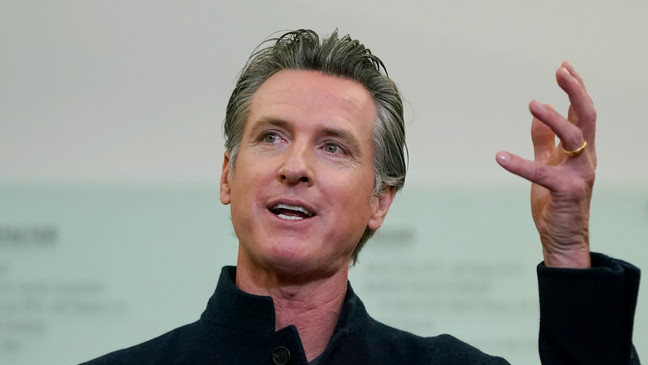
FONTANA – As California emerges from the Omicron surge, Governor Gavin Newsom today unveiled the state’s SMARTER Plan, the next phase of California’s pandemic response. Building on lessons learned over the past two years and the state’s ongoing commitment to equity, the SMARTER Plan will guide California’s strategic approach to managing COVID-19 while moving the state’s recovery forward. Emphasizing continued readiness, awareness and flexibility, the Plan will ensure California can maintain its focus on communities that continue to be disproportionately impacted, and stay prepared to swiftly and effectively respond to emerging COVID-19 variants and changing conditions.
Read the California SMARTER Plan: The Next Phase of California’s COVID-19 Response here.
“As we enter the next phase of the pandemic, the state is better equipped than ever to protect Californians from COVID-19 with smart strategies that save lives and advance our ongoing recovery,” said Governor Newsom, who will outline the Plan today at a state-operated warehouse in Fontana storing personal protective equipment. “Building on proven tools – rooted in science and data – that have been honed over the past two years, we’re keeping our guard up with a focus on continued readiness, awareness and flexibility to adapt to the evolving pandemic. As we have throughout the pandemic, the state will continue applying the lessons we’ve learned about the virus to keep California moving forward.”
The SMARTER Plan’s core pillars and preparedness metrics focus on lifesaving public health measures and strategies the state has successfully used to slow the spread and protect Californians. Recognizing that each variant brings with it unique characteristics relative to the specific conditions in our neighborhoods and communities, the Plan preserves needed flexibility and ensures the state has the resources and capabilities in place to tackle the COVID-19 challenges that lie ahead:
- Shots- Vaccines are the most powerful weapon against hospitalization and serious illness. Under the Plan, California will maintain capacity to administer at least 200,000 vaccines per day on top of existing pharmacy and provider infrastructure.
- Masks- Properly worn masks with good filtration help slow the spread of COVID-19 or other respiratory viruses. The state will maintain a stockpile of 75 million high quality masks and the capability to distribute them as needed.
- Awareness- We will continue to stay aware of how COVID-19 is spreading and evolving variants, communicate clearly how people should protect themselves, and coordinate our state and local government response. California will maintain capability to promote vaccination, masking and other mitigation measures in all 58 counties and support engagement with at least 150 community-based organizations.
- Readiness- COVID-19 isn’t going away and we need to be ready with the tools, resources and supplies that will allow us to quickly respond to protect public health and to keep the health care system well prepared. The state will maintain wastewater surveillance in all regions and enhance respiratory surveillance in the health care system while continuing to sequence at least 10 percent of positive COVID-19 test specimens. The state will also maintain the ability to add 3,000 clinical staff within 2-3 weeks of need and across various health care facility types.
- Testing- Getting the right type of tests – PCR or antigen – to where they are needed most. Testing will help California minimize the spread of COVID-19. California will maintain commercial and local public health capacity statewide to perform at least 500,000 tests per day – a combination of PCR and antigen.
- Education- California will continue to work to keep schools open and children safely in classrooms for in-person instruction. The state will expand by 25 percent school-based vaccination sites supported by the state to increase vaccination rates as eligibility expands.
- Rx- Evolving and improving treatments will become increasingly available and critical as a tool to save lives. The state will maximize orders for the most clinically effective therapeutic available through federal partnerships, ensuring allocations of effective therapeutics are ordered within 48-hours.
The SMARTER Plan maintains the state’s focus on targeted investments and outreach to tackle COVID-19 health disparities in disproportionately impacted communities. The Plan features a new COVID-19 Assessment and Action Unit to monitor data and frontline conditions in real-time. It also includes building upon a robust, regionally-based waste-water surveillance and genome sequencing network to have early and rapid insights into the changing nature of the virus and early identification of variants.
In collaboration with external partners and the federal government, California will launch the first-in-the-nation impacts of COVID-19 longitudinal cohort study to examine the direct and indirect impacts of COVID-19 on individuals and communities over time. Under the Plan, the state is pursuing a public-private partnership with a test manufacturer to drive down the costs of at-home tests while securing a reliable and timely supply chain for California. The state will also continue taking steps to ensure our health care facilities can continue to ramp up with additional staff and resources to respond to potential surges while minimizing strain on our health care systems.
“California is prepared to lean in on the principles that have made us successful in our COVID-19 response. Under the SMARTER Plan, we will use the significant knowledge we have gained and the tools and resources we have developed over the last two years to adapt and respond to whatever is next,” said California Health and Human Services Agency Secretary Dr. Mark Ghaly. “Californians should rest assured we are ready and prepared to meet any public health challenges that may lie ahead.”
Since the onset of the pandemic, California has led the nation’s fight against COVID-19 with early, robust public health measures that have saved tens of thousands of lives, contributing to California’s maintaining one of the lowest death rates among large states. California’s pandemic response to date has administered more than 70 million COVID-19 vaccines; distributed more than 870 million N-95 and surgical masks; deployed more than 28,000 state supported staff to support health care facilities; and administered more than 140 million COVID-19 tests, distributed 33 million at-home COVID-19 antigen tests and established more than 7,500 testing sites statewide. The state has also significantly closed disparities in infection and death rates in disproportionately impacted communities through equity-focused vaccination and testing outreach and culturally-competent engagement and information.
National and state leaders in the public health and health care communities were quick to support the SMARTER Plan:
“California’s SMARTER plan should represent a turning point in managing the pandemic from taking whatever the virus brings us to being prepared to manage whatever challenges come next. This plan will act as a model for states around the country.”
Andy Slavitt
Former Senior Advisor for COVID-19 Response in the Biden Administration
“California’s success in this next phase of the pandemic depends on our focus on those who have borne the brunt throughout: essential workers, older adults, Latino, Black, and Pacific Islander communities, and those with more limited resources. The equitable response is the smarter response, and I hope the plans outlined here receive sustained attention and investment.”
Kirsten Bibbins-Domingo, PhD, MD, MAS
Chair, Epidemiology and Biostatistics
Vice Dean for Population Health and Health Equity
University of California, San Francisco
“California’s thoughtful approach to the pandemic has led to the lowest per-capita death rate of any large American state. Coming out of the Omicron surge, we have to apply all the lessons we’ve learned in the past two years, to be sure that we’re taking the smartest possible approach to this rapidly evolving threat. I was impressed by the SMARTER Plan, which does just that.”
Robert Wachter, MD
Professor and Chair of the Department of Medicine
University of California, San Francisco
“SMARTER is just that. It’s a plan to take all that we’ve learned from the first two years of the COVID-19 pandemic and use that knowledge to go forward. COVID-19 will be with us for several years to come, and having a nimble plan that can respond strategically to the twists and turns the pandemic will undoubtedly take will be invaluable for Californians.”
George W. Rutherford, MD, AM
Professor of Epidemiology, Preventive Medicine, Pediatrics and History
Head, Division of Infectious Disease and Global Epidemiology
Department of Epidemiology and Biostatistics School of Medicine
University of California, San Francisco
“California leads the USA in the most important statistic: fewest deaths per capita from COVID-19 among large states. It is no accident. It takes determined leadership. The last two years have not been easy and the next stage won’t be easy either, but Governor Newsom’s new SMARTER Plan is a very big step forward.”
Larry Brilliant MD, MPH
An American epidemiologist, technologist, philanthropist and author, Brilliant worked with the World Health Organization from 1973 to 1976, helping to successfully eradicate smallpox.
“SMARTER is a comprehensive strategic plan to guide the state of California into the next phase of COVID-19. It covers the important areas of combating COVID-19 and other viruses—from masking to testing to therapeutics. As in so many things, California’s SMARTER program can help the rest of the country to transition to a new normal.”
Ezekiel J. Emanuel, MD PhD
Physician and Vice Provost of Global Initiatives
University of Pennsylvania
Governor Newsom has implemented robust measures to protect Californians throughout the pandemic, including requiring that health care workers get boosted, expanding access to testing for students and Californians across the state, proposing to add the COVID-19 vaccine to the list of vaccinations required to attend school in-person when fully authorized for applicable grade spans, and implementing a standard that all school staff and all state workers either show proof of full vaccination or be tested at least once per week. Last year’s budget appropriated $1.7 billion to combat COVID-19 in fiscal year 2021-22. Now, Governor Newsom’s $3.2 billion COVID-19 Emergency Response Package, including $1.9 billion in early action funding that has already been approved, will help bolster the state’s ongoing vaccination and testing efforts, support workers, strengthen the health care system and combat misinformation.
###






